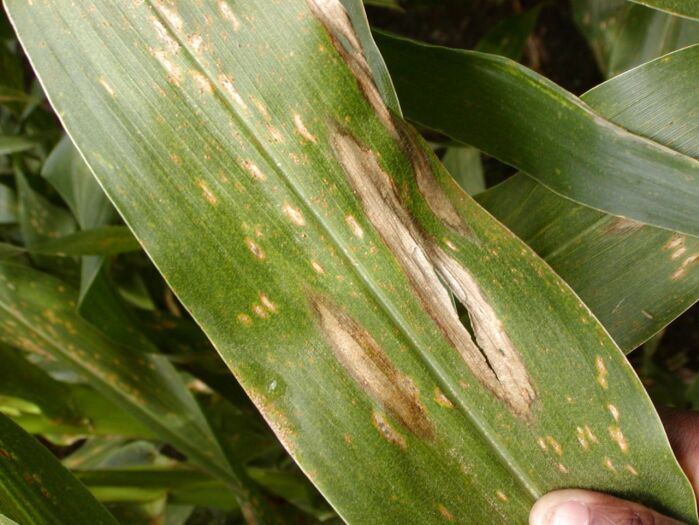
Articles
Managing Northern Leaf Blight

Cool, moist conditions in late summer and early autumn resulted in a favourable environment for the development of northern leaf blight (NLB) in some parts of the country.
Even though yield impact is likely to be minimal for the majority of crops, due to late infection, close monitoring for stalk integrity will be critical to minimise lodging losses.
NLB is a foliar fungal disease of maize that requires an extended period of dew (over six hours) at temperatures between 18oC and 27oC to develop; it is incapable of producing spores when there is not a sufficiently long period of continuous humidity.
Infection initially appears as long, narrow, tan lesions running parallel to leaf margins and over time, these lesions may merge to form large, irregular areas of dead tissue on the leaves, resulting in loss of surface leaf area for photosynthesis.
Conditions favouring NLB:
After harvest, the NLB fungus survives through winter on infected maize residue. In late spring or early summer, fungal spores from the residue are then either rain-splashed or wind-blown to the new crop.
Leaving large amounts of infected residue exposed on the surface will predispose the crop to infection by providing large amounts of inoculum early in the season. Crops planted in no-till or reduced-till systems are consequently more prone to NLB than conventional tillage.
It is not uncommon for some paddocks to show symptoms while neighbouring paddocks planted to a similar hybrid appear clean. This occurrence could be due to different management practices or paddock orientation. Low lying paddocks that receive heavy dew and fog are prone to greater disease progression. Weedy conditions that obstruct airflow can elevate humidity, which is a key ingredient for disease infection. Stressed crops will also be more prone to infection due to compromised natural immunity.
Disease impact
Yield loss from NLB is primarily due to loss in photosynthetic leaf area.
Timing of infection and weather conditions has a significant influence on yield impact, with losses as high as 30% occurring if lesions are present on the ear leaf or higher prior to or at tasselling. If lesions do not appear on upper leaves until late in the season, yield losses will be minimal.
In addition to yield losses, infected plants may have reduced forage value. The reduced surface leaf areas can also predispose the crop to stalk rots and consequently stalk lodging, which may require heavily infected crops to be harvested early.
Disease management
While environment plays a huge role, susceptibility to NLB will vary by maize hybrid. Management practices will influence the degree of tolerance level: a susceptible hybrid planted under favourable conditions for disease development will result in the disease materialising, and a hybrid with a reasonable NLB rating may also show symptoms if growing conditions are not conducive for optimum maize growth.
Even though NLB outbreaks are difficult to predict, occurrence can be minimised through simple preventative strategies.
Though fungicides are available for in-season management, few are registered in New Zealand and the long withholding period for most of these fungicides limit application timing to pre-tasseling. The repeated spraying required can be costly.
Currently, the best primary management strategy to reduce the incidence and severity of NLB is planting resistant products. Pioneer® uses a 1 – 9 rating scale to indicate the degree of resistance, where 1 is poor and 9 is best. Where NLB risk is high, selecting hybrids with an NLB rating of 6 or better is advisable.
Continuous maize, reduced or no-till maize systems can promote residue build up on the soil surface so where NLB is likely an issue, tillage or other management practices that incorporate residues will help enhance debris decomposition. This will help reduce infection levels by decreasing the amount of primary inoculum available in the spring.
Where a rotation option exists, for example with silage crops on the dairy platform, a maize-pasture-maize rotation may be effective, though a two-year rotation will be required for a reduced or no-tillage system. Rotation will reduce disease levels by allowing the debris on which the fungus survives to decompose before maize is planted again.
If NLB was evident in your crops this year, residue management will be important. Selecting a hybrid that possess good NLB ratings and then following the best management practices will help minimise disease occurrence in next season’s crop.
